星际高速公路使太空旅行更简单
07.17.02
阿“高速公路”,通过太阳能类似一个虚拟绕组隧道和绕太阳和由美国宇航局喷气推进实验室,加利福尼亚州帕萨迪纳的工程师设想可以削减对未来空间需要的燃料数量的行星,管道广大阵列系统任务。
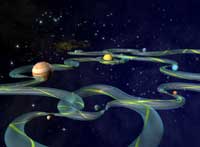 图片的右侧: 艺术家的概念星际高速公路。
图片的右侧: 艺术家的概念星际高速公路。
+点击充分图片。图片来源:NASA /喷气推进实验室。
所谓的星际高速公路,该系统的构思是由马丁罗,其软件被用于帮助美国航空航天局设计的创世纪的使命,目前在太空中使用这个“高速公路上的使命”,以收集返回地球的太阳风粒子的飞行路线。
大多数特派团的目的是利用重力的方式在一个航天器时,由一个机构波动,如行星或卫星拉优势。罗的概念注意到另外一个因素的优势,太阳的引力对行星或行星的卫星在其附近的拉。从许多方向的力几乎相互抵消,使通过重力场中,航天器可行走路径。
每个行星和月亮有5个在太空中的位置称为拉格朗日点,其中一个身体的重力平衡他人。航天器轨道燃烧时有很少的燃料。要找到星际高速公路,一些老映射拉格朗日点之间的可能飞行轨迹,不同的距离飞船将去的速度有多快或慢会旅行。像扭在一起,形成一根绳子线程,可能飞行轨迹在空间管组成。罗计划绘制出整个太阳系内管。
罗的研究是根据19世纪后期开始由法国数学家庞加莱理论工作。 1978年,美国宇航局的国际合作地球太阳探测器3是第一个任务,在用拉格朗日点低能量的轨道。后来,使用地球与月球,美国宇航局戈达德太空飞行中心,戈达德,控制器发出低能量路径飞船与彗星,彗星贾科比尼- Zinner表示在1985年,第一次遇到。
1991年,另一个低能量轨道分析方法用于由喷气推进实验室的工程师和日本航天局,使日本飞天任务到达月球。这一开创性工作和在巴塞罗那大学的科学家进行的一项研究的启发,罗构想的星际高速公路理论。
罗和他的同事已经变成一种被称为“LTool,”任务设计工具的星际高速公路使用的基本数学模型和普渡大学,西,印第安纳州Lafayette新LTool是由喷气推进实验室的工程师使用,重新设计开发的算法飞行创世纪任务的道路,以适应在发射日期的改变。起源于2001年8月推出。
飞行方向是设计的飞船离开地球,前往轨道拉格朗日点。经过五年解决此拉格朗日点循环,飞船将被排除在轨道没有任何动作,然后经过地球地球对面的一拉格朗日点。最后,它将返回地球上层大气落在犹他州的沙漠太阳风的样本。
“创世纪不会需要使用,所有在世界上任何一个完美的燃料,”罗说。 “但由于我们无法控制的,在整个任务发生的变数太多,我们要完成的起源围绕地球拉格朗日点的循环一些更正。对节省燃油的转换。成为一个更好,更便宜的使命”
罗说:“这一概念并不能保证容易获得的每一个太阳系的一部分。但是,我可以预想到的地方,我们可以建设和服务围绕月球的拉格朗日点一个科学的平台。由于拉格朗日点的星际风景名胜高速公路,我们也许可以分流飞船,从这种平台。“阿国家航空航天局约翰逊航天中心,休斯敦,队与美国航天局勘探队的工作,提出有一天能利用未来的人类空间飞行的星际高速公路。
“罗的工作已使简化超越人类和机器人低地球轨道探测任务概念的突破,”道格库克说,约翰逊的高级开发办公室经理。 “这些更少的空间的任务需要广泛的选择车辆简化的结果。”
在高速公路上的行星际空间的设计工作任务被提名为探索创新奖由发现杂志的编辑功能和一个外部专家小组。
喷气推进实验室是美国航天局管理的技术,帕萨迪纳加州理工学院。更多关于起源特派团的信息,请访问网址: http://genesismission.jpl.nasa.gov/。
See the talk by Shane Ross!
RealVideo of talk: [56k modem] [broadband] [cable/DSL]
What is the Interplanetary Superhighway?
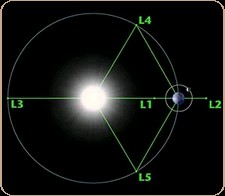 |
| Figure 1. The locations of the Lagrange points-- fixed points for a spacecraft in a sun-planet gravity field. |
Our solar system is interconnected by a vast system of winding tunnels and conduits in space around the sun and planets which we call the ?Interplanetary Superhighway? or IPS for short (Lo and Ross [1], [2]). This ancient and giant labyrinth around the Sun is generated by the Lagrange points of all of the planets and satellites within the solar system. For every three body system (such as the sun-planet-spacecraft system), there are five Lagrange points (also known as libration points). These points are special locations in space where the gravitational forces and the rotational forces within the three body system are balanced, as shown in Figure 1. They were discovered by Euler (L1, L2, L3) and Lagrange (L4, L5).
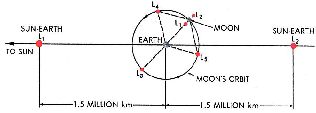 |
| Figure 2. Location of the Lagrange points in the Earth's neighborhood (click to enlarge). |
Figure 2 shows schematically the Lagrange points of the Earth-Moon System and their geometric relationship with the Sun-Earth?s L1 and L2. For clarity, we will refer to the lunar Lagrange points as LL1, etc., and the Earth Lagrange Points as EL1, etc. We refer to the region of space around the Earth containing all of these Lagrange points as the ?Earth?s neighborhood?. It is a sphere of roughly 1.5 million km (1 million miles) radius around the Earth. Figure 3 provides an artist conception of a portion of the IPS in the Earth?s neighborhood connecting the Lunar LL1 Gateway with spacecraft in orbit about Earth?s EL2 described in [2].
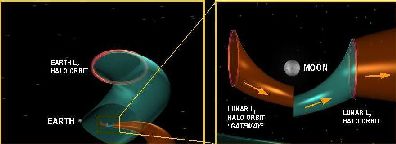 |
| Figure 3. The IPS in the Earth's neighborhood connecting the Lunar L1 Gateway with spacecraft in orbit about Earth?s L2. (click to enlarge). |
For an exposition on the dynamics of the Lagrange points and the foundations of IPS, see Koon, Lo, Marsden, and Ross [3] and references therein as well as the papers at the recent conference in Spain on ?Libration Orbits and Applications? [4].
Brief Historical Sketch
The Interplanetary Superhighway is based on a mathematical concept known as invariant manifolds (the tubes). Invariant manifolds are a part of dynamical systems theory (chaos theory) created by Poincar頩n his celebrated study of the three body problem in the late nineneenth century. Carles Simd his group in Barcelona were the first to systematically apply dynamical systems theory to space mission design. Unfortunately, their seminal work for ESA on the SOHO mission was not used. Please see the next two pages for more information on the Interplanetary Superhighway and definitions of technical terms.
The work of Simgroup on invariant manifolds and dynamical systems theory in the late 1980?s gave rise to the question of whether the invariant manifold tubes of one planet might intersect the tubes of another planet to provide a means of transport between the planets? Pursuit of these ideas with many colleagues has resulted in the body of work supporting the theory and use of the Interplanetary Superhighway.
When various proposals for libration missions came along, a partnership with Purdue University was formed to develop and apply invariant manifold theory for these missions. This included the design of the Genesis trajectory. Genesis was not the first mission using the pathways within the Interplanetary Superhighway (i.e. the invariant manifolds of the Sun-Earth-Moon system). As it is a natural phenomenon, of course, any object in that vicinity has to use those pathways. However, the theoretical approach and the computation algorithms used to design the Genesis trajectory are based on invariant manifold theory.
The fact that the theory of invariant manifolds was used in the design of the Genesis trajectory in no way diminishes the work of Robert Farquhar and others on earlier Lagrange point missions. He not only coined the name ?halo orbits?, he convinced NASA to fly the historic first libration mission, ISEE-3/ICE. He opened the door for the rest of the world to follow. Today, libration orbits are not only accepted by the space community, but have become a popular location for a great variety of missions. Many of these have been conceived of by Robert Farquhar. We are building on the work that he and his team began.
Definition of the Interplanetary Superhighway
Please refer to the technical concepts and definitions section for more details of the terminology used.
? What is the Interplanetary Superhighway (IPS)?
- The Interplanetary Superhighway: The ?Interplanetary Superhighway? is a term used to describe the network of tubes formed by low-energy trajectories connecting the bodies of the Solar System. The contribution of this work has been the development of new technologies for space trajectory design and dynamical astronomy using modern mathematical and computational methods in the N-body problem.
- Invariant Manifolds of Periodic & Quasiperiodic Orbits: The Interplanetary Superhighway is the network of trajectories generated by the collection of invariant manifolds (stable and unstable manifolds which in the 2 dimensional case form tubes) of all of the unstable periodic and quasiperiodic orbits within the Solar System.
- Solar System as Coupled Three Body Problems: The Solar System here is modeled as a series of ?coupled circular restricted 3 body problems? (CCRTBP).
- Interplanetary Superhighway in Other Solar System Models: For trajectories of short duration such as needed for mission design, the Interplanetary Superhighway can be realized in more sophisticated models of the Solar System (e.g. the JPL ephemeris model) using methods such as multiple shooting (differential correction) or continuation. To study long-term average behavior, symplectic integration may be used.
? How does it work?
- Provide Interplanetary Transfer Via Intersecting Manifolds (Tubes): Between planets, and between a planet and its satellites, the manifolds (tubes) may intersect in position space (configuration space) to provide opportunities for moving from one manifold to another.
- May Require Propulsion: One may be able to travel large distances in the Interplanetary Superhighway without any propulsion. However, this may not always be the case. This is because the manifolds are actually in phase space which includes both position and velocity. Thus for true intersection to occur, the velocities must also match. Since the manifolds more frequently intersect in position space than in phase space, a change in velocity may be required.
? Why are these orbits so inexpensive to control?
- Trade Time vs. Energy: The energies required by the trajectories to travel on the Interplanetary Superhighway are typically cheaper propulsively than standard transfers. But this may require much longer time.
- Chaos Provides Cheap Control: The invariant manifolds of unstable orbits frequently are the sources of chaotic motion. When chaos is present, the orbits become very sensitive. A slight change at one point can cause great variations in the orbital behavior far away. Thus only a small control force is needed to make large changes in the behavior for such trajectories.
? Distinction Between Transport vs. Transportation: We make the distinction between the ?Transport of Natural Objects? such as comets and asteroids, and the ?Transportation of Artificial Objects? such as spacecraft.
- Transportation Applications are Best in the Planet?s Neighborhood: The Interplanetary Superhighway is most effective in transportation applications in the ?neighborhood of a planet?, a large region encompassing the L1 and L2 Lagrange points of the planet.
- Impractical for Interplanetary Transfers Due to Long Transfer Time: Due to the long time needed to achieve the low energy transfers between planets, the Interplanetary Superhighway is impractical for transfers such as from Earth to Mars at present.
- May Play Significant Role in Low Thrust Trajectory Design and Optimization: Preliminary work indicates invariant manifolds provide the natural low-energy pathways which may be used to speed up the design and optimization of low thrust trajectories.
- Applications to the Theory of Transport in the Solar System: The temporary capture of comets by Jupiter such as Gehrels 3, Oterma, Helin-Roman-Crockett have been explained using invariant manifold theory (in the journal of Chaos ) Transport coefficients for asteroids escaping Mars have been computed using invariant manifold theory (as reported in Physical Review Letters)
Technical Concepts and Definitions
In order to understand the basic components of the Interplanetary Superhighway, some basic concepts and definitions from mathematics are helpful and provided here.
? Three Body Problem: The three body problem studies the motions of three bodies moving under the influence of their mutual gravitation such as the motions of the Sun-Earth-Moon system.
? Circular Restricted Three Body Problem (CRTBP): The CRTBP is a simplification of the Three Body Problem where the third body is assumed to have very small mass which is infinitesimal. Hence it exerts no force on the two other bodies called Primaries. The motion of a spacecraft under the gravity of the Sun and the Earth can be modeled this way. A further simplification assumes that the primary bodies are moving in circular orbits about one another. This is the CRTBP.
? Coupled CRTBP: This is a model of the four body problem such as for a comet moving in the Sun-Jupiter-Saturn system. We model it as two CRTBP?s, the first one is the Sun-Jupiter-Comet CRTBP model, the second is the Sun-Saturn-Comet CRTBP model. Jupiter and Saturn are assumed to not exert gravitational force on one another. We may add additional planets in this fashion to model the solar system as a series of coupled CRTBP?s.
? Manifold: A manifold is the mathematical term for a surface of arbitrary dimension. Familiar? 1-dimensional manifolds are lines, curves in space, the circle, a helix. Familiar 2-dimensional manifolds are the plane, a sphere, the doughnut (also called torus), and the cylinder. In our context, the manifold of interest are surfaces made up of trajectories and orbits.
? Periodic Orbit: An orbit which closes on itself. Fixed points, circular, elliptical, and halo orbits are examples of periodic orbits. Topologically, all periodic orbits are either points or deformed circles.
? Quasiperiodic Orbit: An orbit which winds around a torus (doughnut-shaped manifold) but which? never closes on itself. It is the simplest generalization of the periodic orbit. Lissajous orbits are examples of quasiperiodic orbits. The Genesis orbit around L1 is a Lissajous orbit.
? Stable and Unstable Orbit: An orbit is unstable if slight perturbations will cause the spacecraft moving on the orbit to leave the orbit and move far away. Otherwise, it is stable. L1 and L2, halo and Lissajous orbits are all unstable orbits.
? Invariant Manifold: An unstable periodic orbit in a Hamiltonian system (a general class of differential equations which includes the three body problem) have associated two families of orbits forming tubes connected to the periodic orbit. One family of orbits asymptotically approaches the periodic orbit. This family is called the stable manifold. The other family of orbits asymptotically departs from the periodic orbit. This family is called the unstable manifold. Invariant manifold theory was developed by Henri Poincar頩n the late nineteenth century when he studied the three body problem. It is a part of dynamical systems theory. Unstable quasiperiodic orbits also have similar invariant manifolds.
? Dynamical Systems Theory: Dynamical systems theory is also known as the geometric theory of differential equations or global analysis. It is popularly called ?chaos theory?. It was created by Henri Poincare when he studied the three-body problem in the late nineteenth century. Invariant manifold theory is a part of this work.
? Deterministic Chaos: This type of chaotic motion is generated not by random statistical fluctuations, but by its extreme sensitive dependence on the initial conditions for the differential equations describing this motion. The effect is a small change at one part of a trajectory can make a great changes elsewhere. This is how low-energy trajectories are obtained.
Notes
[1] Lo, M., S. Ross, ?SURFing the Solar System: Invariant Manifolds and the Dynamics of the Solar System?, JPL IOM 312/97, 1997.
[2] M. Lo, S. Ross, ?The Lunar L1 Gateway: Portal to the Stars and Beyond?, AIAA Space 2001 Conference, Albuquerque, NM, August 28-30, 2001.
[3] W.S. Koon, M. Lo, J. Marsden, S. Ross, ?Heteroclinic Orbits between Periodic Orbits and Resonanace Transitions in Celestial Mechanics?, Chaos, Vol. 10, No. 2, June, 2000.
[4] The web site of a recent international conference organized with colleagues in Spain on ?Libration Orbits and Applications? describes some of the state-of-art work being done by space agencies, universities, and industry around the world using these ideas as well as other methods. It is:
http://www.ieec.fcr.es/libpoint/main.html
什么是星际高速公路?
我们的太阳系是由一对相互缠绕在太空围绕太阳和行星,我们称之为大隧道和管道系统 ?星际高速公路? 或 新闻通讯社 (简称劳和罗斯[1],[2])。环绕太阳这片古老而巨大的迷宫,是产生的行星和卫星,拉格朗日点在太阳系内。每3个(如太阳机构系统的行星,卫星系统),有5个拉格朗日点(也称为天平动点)。这些要点是特殊的地点,空间,在重力和身体内的三个系统的旋转力量平衡,如图1所示。他们发现欧拉(第一级,二级,三级)和拉格朗日(腰椎,腰)。
图1。 的拉格朗日点的位置-固定在一个阳光航天器,地球重力场点。
图2显示了图式地球的拉格朗日点月亮系统以及它们与太阳的几何关系,地球?的L1和L2。为了明确起见,我们将提到作为LL1等月球拉格朗日点,地球拉格朗日点作为EL1电池等,我们指的是空间周围的载有作为?地球?拧拉格朗日点附近,这些地球上所有地区?。这是一个约150万公里(1万英里)球半径环绕地球。图3提供了一个在地球上的部分艺术家的IPS概念?拧街道,连接在地球轨道航天器对月球LL1网关?拧EL2电池描述[2]。
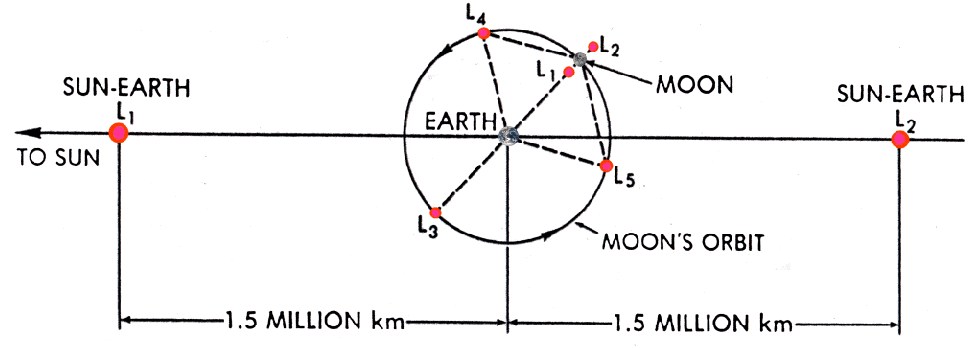
图2。 拉格朗日点的位置在地球的邻居(点击放大)。
对于对动力和拉格朗日点的IPS的基础的论述,见观,罗,马斯登和罗斯[3]以及其中参考资料,以及在西班牙呢?天平动轨道和应用程序最近一次会议的文件? [4]。
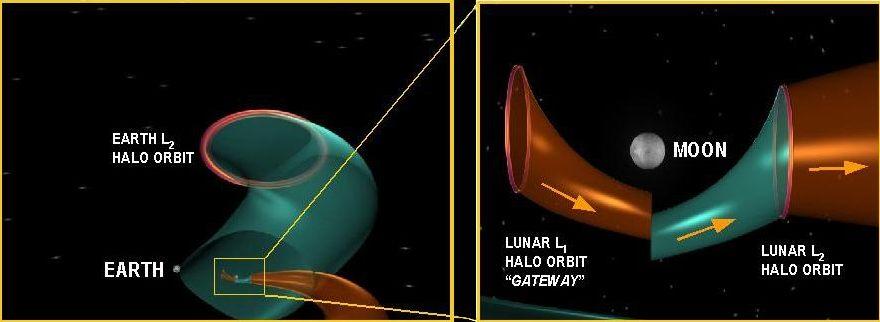
图3。 在地球的连接在地球轨道航天器对月球附近的一楼网关的IPS?š二级。 (点击放大)。
简单的历史素描
行星际高速公路是基于为(管)不变流形著名的数学概念。不变流形的动力系统理论(混沌理论)的庞加莱頩ñ他创造了著名的三体问题研究后期nineneenth世纪的一部分。普约尔星际Ḏ他在巴塞罗那组首先系统地运用理论,动力系统的空间飞行任务的设计。不幸的是,他们对欧空局的开创性工作任务的SOHO没有使用。请参阅更多关于星际高速公路和信息技术术语的定义下两页。
在星际组不变流形和理论工作的动力系统在80年代后期?拧引起了是否在一个星球上不变流形管会相交的另一个星球的管子提供行星之间的运输问题的一种手段?这些想法与追求,导致很多同事在工作机构的支持理论和行星际高速公路的使用。
当解放使命的各种提案出现了,与美国普渡大学合作成立了开发和应用这些任务不变流形的理论。这包括轨道设计的起源。创世纪不是第一次访问星际内使用高速公路的途径(即太阳的不变流形,地月系统)。由于这是一种自然现象,当然,任何在附近的对象使用这些途径。然而,理论的计算方法和算法来设计创世记轨迹是基于不变流形的理论。
该说,不变流形理论在创世记绝不轨迹设计使用这一事实削弱了罗伯特法夸尔和前拉格朗日点其他机构的工作任务。他不仅创造了这个名字?晕轨道?,他说服美国宇航局飞行任务历史性的第一次解放,ISEE-3/ICE。他打开了世界其他国家的大门走。今天,振动轨道不仅接受空间界,而且已成为一个多种任务的热门场所。其中许多已通过体外受精罗伯特法夸尔的。我们正在建设的工作,他和他的团队开始了。
定义的行星际高速公路
请参阅 技术概念和定义 术语的更多细节部分使用。
? 什么是星际高速公路(IPS)的?
- 行星际高速公路: 的?星际高速公路?是用来描述由低能量连接太阳系形成的机构轨迹管网一期。这项工作的贡献是空间轨道设计和动力学天文学新技术的开发利用在N现代数学和计算方法体问题。
- 不变流形轨道周期和准周期: 行星际高速公路,是由集合生成的不变流形的轨迹网络(稳定和不稳定流形的,在二维情况下形成管)对不稳定周期和准周期内的所有太阳系轨道。
- 太阳能系统的耦合问题的三个机构: 太阳系这里建模为一个系列?加上圆形限制3体问题? (CCRTBP)。
- 星际高速公路在其他太阳系模型: 对于短期的轨迹,如设计任务需要,星际高速公路可以实现在太阳系更复杂的模型(如星历表的喷气推进实验室模型)采用如多重射击(差分修正)或继续方法。研究长期平均水平的行为,辛一体化可以使用。
? 它是如何工作的?
- 提供星际传输和通过交叉形(管): 行星之间,与1地球及其卫星,歧管(管)可在空间位置(配置空间)相交,为从一个流形转移到另一个机会。
- 可能需要推进: 一个可以旅行没有任何推进高速公路在星际大的距离。但是,这可能并非总是如此。这是因为流形在相空间内包括了位置和速度实际。因此,对于真正的十字路口发生的速度也必须匹配。由于流形更加频繁交叉位置的空间比在相空间中,在速度可能有所改变。
? 为何如此便宜,这些轨道控制?
- 交易时间与能源: 由轨道所需的星际旅行高速公路的能量通常比标准的便宜propulsively转移。但是这可能需要更长的时间。
- 混沌提供廉价控制: 轨道的不稳定流形的不变经常是混沌运动的来源。当混乱目前,轨道变得非常敏感。阿的一点微小变化可能会导致在轨道的行为很大的差异远。因此,只有一小的控制力量,才能把在这种大的变化轨迹的行为。
? 区分运输与交通: 让我们之间的自然物体?运输的区别?比如彗星和小行星,以及人造物体?交通运输?如航天器。
- 交通的应用是世界上最好的?š周边环境: 行星际高速公路是最有效的,在一个星球?邻里运输应用?,一个大区域,围绕地球的L1和L2拉格朗日点。
- 不切实际的星际转移由于长期传输时间: 由于长时间才能实现行星间的低能量转移,行星际高速公路是如从地球到火星目前的转让是不切实际的。
- 可能发挥的重要作用小推力轨道设计与优化: 初步工作表明不变流提供了天然的低能量,可以用来加速设计和低推力轨迹优化途径。
- 在太阳系中的应用运输理论: 在临时捕获彗星木星如 Gehrels 3,奥泰尔马,和林,罗马克罗克特 使用已解释不变流形理论(在杂志 混沌 ) 为逃避火星陨石运输系数计算已使用不变流形理论(如在 物理评论快报)
技术概念和定义
为了了解星际高速公路的基本组成部分,一些基本概念和数学是有帮助的定义,并提供在这里。
? 三体问题: 三体问题的三个研究机构的议案根据其相互引力的影响,移动,如太阳的运动,地月系统。
? 圆形限制性三体问题(CRTBP): 该CRTBP是三体问题简化机构在第三个假设都非常小的量,是微不足道的。因此,它潜移默化的其他两个团体,任何势力称为三原色。根据太阳的引力议案的航天器和地球进行建模这种方式。进一步简化假设的主要机构,在环形轨道移动一个人似的。这是CRTBP。
? 耦合CRTBP: 这是一个四体问题的模式,如彗星在太阳移动,木星,土星系统。我们的模式是两个CRTBP?秒,第一个是太阳,木星,彗星CRTBP模式,第二个是太阳土星彗星CRTBP模式。木星和土星都假定不相互施加引力。我们可以用这种方式添加更多的行星的模型作为耦合CRTBP系列太阳能系统?第
? 多方面的: 一个流形是一个任意尺寸表面数学术语。熟悉? 一维流形线,在空间曲线,圆,一个螺旋。熟悉的二维流形的平面,球面的甜甜圈(也称为环)和气缸。在我们方面,利息流形曲面组成的轨迹和轨道。
? 周期轨道: 一个轨道上依靠自己的休息。固定点,圆形,椭圆形,晕轨道的周期轨道的例子。拓扑,所有的周期轨道或点或变形圈。
? 准周期轨道: 周围的轨道环(甜甜圈的风形流形),但? 从来没有关闭自己。这是最简单的概括周期轨道。利萨茹轨道是准周期轨道的例子。在L1起源的轨道是一个沙育轨道。
? 稳定和不稳定轨道: 不稳定的轨道上,如果稍有扰动将导致飞船在轨移动到离开轨道和移动远。否则,它是稳定的。 L1和L2,晕和沙育轨道都是不稳定的轨道。
? 不变流形: 一个不稳定的周期轨道的哈密顿系统(一个微分方程一般类,其中包括三个体问题)有关联的两个形成连接管轨道周期轨道的家庭。一个家庭的轨道接近渐近周期轨道。这个家庭被称为 稳定流形。其他家庭的轨道渐近周期轨道的偏离。这个家庭被称为 不稳定流形。不变流形理论是由庞加莱頩n的19世纪晚期,他研究了三体问题。这是一个理论动力系统的一部分。准周期轨道不稳定也有类似的不变流形。
? 动力系统理论: 动力系统的理论也被称为微分方程或全球性的分析,几何理论。这是俗称?混沌理论?。它是由庞加莱时,他研究了19世纪后期的三体问题。不变流形理论是这项工作的一部分。
? 确定性混沌: 这种类型的混沌运动不是由随机产生的统计的波动,但其极端就说明这个议案微分方程的初始条件的敏感依赖性。效果是在的一个小的变化轨迹的一部分可以在其他地方作出的巨大变化。这就是低能量的轨迹得到。
注释
[1]罗米,罗斯,?冲浪太阳系:不变流形和太阳系的动力?,喷气推进实验室移徙312/97,1997。
[2]米罗,罗斯,?农历一楼网关:门户网站的明星和超越?,AIAA空间2001年会议,新墨西哥州,8月28-30日,2001年。
[3] W.S.观,米老,J.马斯登,罗斯,?异宿轨道的天体力学?周期轨道之间的过渡和Resonanace,混沌,卷。 10,第2号,2000年6月。
[4]最近在西班牙的国际同事?天平动轨道与应用组织会议的网站?描述的国家的一些先进的工作正在做各空间机构,大学和工业界使用周围的这些想法,以及世界其他方法。它是:
http://www.ieec.fcr.es/libpoint/main.html